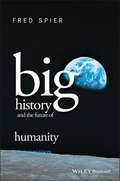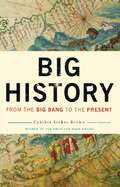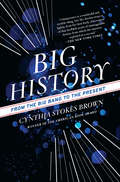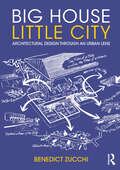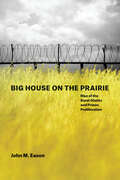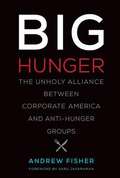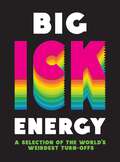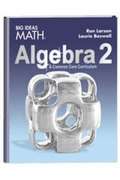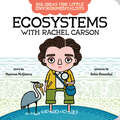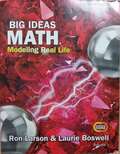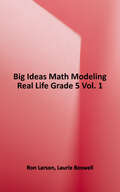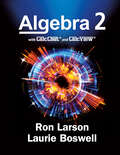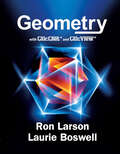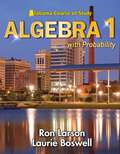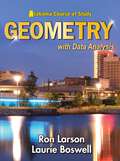- Table View
- List View
Big History and the Future of Humanity
by Fred SpierFeaturing a variety of updates and revisions, Big History and the Future of Humanity, Second Edition, presents an accessible and original overview of the entire sweep of history from the origins of the universe and origins of life on Earth up to the present day. Provides an accessible and original overview of the entire sweep of history that places human history within the context of the history of life, the Earth, and the universe Offers new insights into the future of humanity by providing a better understanding of the past Features a variety of updates and revisions that include increased coverage of key concepts such as the emergence of human behaviour, the development of value systems, and patterns of complexity in Big History Incorporates a variety of 'little big histories' that aid readers in recognizing how big history concepts can relate to their daily lives Instructor resources from the author will be available online upon publication Find additional resources from the author online at www.bighistory.info
Big History: Between Nothing and Everything
by David Christian Craig Benjamin Cynthia BrownBig History: Between Nothing and Everything surveys the past not just of humanity, or even of planet Earth, but of the entire universe. In reading this book instructors and students will retrace a voyage that began 13.7 billion years ago with the Big Bang and the appearance of the universe. Big history incorporates findings from cosmology, earth and life sciences, and human history, and assembles them into a single, universal historical narrative of our universe and of our place within it. <P><P> The first edition of Big History: Between Nothing and Everything, is written by the pioneers of the field, and presents a framework for learning about anything and everything. It encourages students to think critically about our cumulative history and the future of the world through a variety of lenses.
Big History: From the Big Bang to the Present
by Cynthia Stokes BrownAn epic for our time, Big History begins when the universe is no more than a single point the size of an atom, squeezed together in unimaginable density, and ends with a twenty-first-century planet inhabited by 6.1 billion people. It's a story that takes in prehistoric geology, human evolution, the agrarian age, the Black Death, the voyages of Columbus, the industrial revolution, and global warming. Historian Cynthia Brown visits the Vikings, the Mayas and Aztecs, the Incas, the Mongol empire, and the Islamic heartlands. Along the way she considers topics as varied as cell formation, population growth, global disparities, and illiteracy, creating a stunning synthesis of historical and scientific knowledge of humanity and the earth we inhabit.Big History represents a new kind of history, one that skillfully interweaves historical knowledge and cutting-edge science. In an age of global warming, when the fate of the earth hangs in the balance, scientific advances permit us to see the universe as never before, grasping the timescales that allow us to understand the history of mankind in the context of its ecological impact on the planet. Cynthia Brown's lucid, accessible narrative is the first popularization of this innovative new field of study, as thrilling as it is ambitious.
Big History: From the Big Bang to the Present
by Cynthia Stokes Brown&“This exciting saga crosses space and time to illustrate how humans, born of stardust, were shaped—and how they in turn shaped the world we know today.&” —Publishers Weekly This book offers &“world history on a grand scale&”—pulling back for a wider view and putting the relatively brief time span of human history in context. After all, our five thousand years of recorded civilization account for only about one millionth of the lifetime of our planet (Kirkus Reviews). Big History interweaves different disciplines of knowledge, drawing on both the natural sciences and the human sciences, to offer an all-encompassing account of history on Earth. This new edition is more relevant than ever before, as we increasingly grapple with accelerating rates of change and, ultimately, the legacy we will bequeath to future generations. Here is a path-breaking portrait of our world, from the birth of the universe from a single point the size of an atom to life on a twenty-first-century planet inhabited by seven billion people.
Big Hit Entertainment and Blockbuster Band BTS: K-Pop Goes Global
by Anita Elberse Lizzy WoodhamBang Si-Hyuk ('Hitman Bang') is the founder and co-chief executive officer of Big Hit Entertainment, the company behind BTS, a 'K-pop' band that has found unparalleled success around the globe-a remarkable feat given that most of their songs are in Korean. It is March 1, 2020. With its latest album, the band has now scored its fourth chart-topping album in the U.S. in less than two years. The band's popularity has been extremely lucrative: by some estimates, the BTS ecosystem accounts for a staggering $4.9 billion of South Korea's GDP. While K-pop has been dominated by three large companies-SM, YG, and JYP-since the mid 1990s, with BTS Bang arguably has created a K-pop phenomenon that is more global than any act the 'big three' have ever overseen. And whereas K-pop is traditionally associated with long-term, exclusive contracts between companies and their acts that pay the talent relatively modestly and give them little control, Bang seeks to foster a more balanced relationship with his superstar act. Is BTS well-positioned to sustain its success? Can Big Hit replicate that success with the select few other acts in its portfolio? And what does that say about the future of K-pop, and the manner in which music companies will manage the relationships with their talent?
Big House Little City: Architectural Design Through an Urban Lens
by Benedict ZucchiCombining architectural and urban thinking in an unusual and engaging way, this book presents an integrated approach to architectural theory and design. Leon Battista Alberti’s assertion in his famous Renaissance treatise that ‘the city is like a big house, and the house is in turn like a little city’ forms the springboard for a series of reflections on architecture’s relationship with urbanism and how their once intimate symbiosis, unravelled by International Style Modernism, can be recovered. Explicit references to Alberti’s house-city phrase have been made by figures as diverse as the architects Louis Kahn, Aldo Van Eyck, Denys Lasdun and Niels Torp and novelist Italo Calvino. But, as the book shows, thinking of buildings as little cities provides a new lens through which to reappraise the contributions of many other architects, including Le Corbusier, Frank Lloyd Wright, Alvar Aalto, Eliel Saarinen, Bernard Rudofsky, Hans Scharoun, Leon Krier, Fumihiko Maki, Charles Correa and Team 10. In doing so, the author identifies common themes that form an unexpected bridgehead between the urban and architectural approaches of Antiquity, the Middle Ages, Renaissance and 20th century. The book explores buildings from across the globe, including lesser-known projects, such as Wright’s unbuilt house in Italy or Saarinen’s master plan for Cranbrook Academy, as well as more recent projects by Niels Torp, Behnisch Architekten, Sou Fujimoto, Peter Barber and WOHA. It concludes with practical case studies of residential, health, education and workplace projects from different countries, fulsomely illustrated with many drawings and photographs. These show how architectural design viewed through an urban lens provides a conceptual framework for breaking down the scale of large buildings and integrating them with their context. And crucially, these also show a very accessible way of explaining evolving designs to the intended users and eliciting their participation in the design process. The book offers a compelling approach to the design of projects at all scales, within an ecological perspective: the sense that big and small, cities and buildings must be approached holistically if we are to reverse the degradation and depletion of our habitat, both natural and man-made.
Big House on the Prairie: 75 Years of the University of Nebraska Press
by University of Nebraska PressIn 2016 the University of Nebraska Press celebrates its 75th anniversary. Proudly rooted in the Great Plains, the Press has established itself as the largest and most diversified publisher located between Chicago and California. The achievements of a vast network of devoted authors, editors, board members, series editors, and staff, the Press has published more than 4,000 books and more than 30 journals of influential and enduring value.What started as a one-person operation at a land grant institution on the sparsely populated plains of Nebraska has tenaciously grown into a press that has earned an international reputation for publishing notable works in Native studies, history, anthropology, American studies, sports, cultural criticism, fiction, fiction in translation, creative nonfiction, and poetry. Winning numerous awards through the years, most notably several Nobel Prizes, the Press has contributed richly to the state, the region, and far beyond. The Press’s partnership with the Jewish Publication Society has placed an emphasis on books in Jewish studies and Bible studies, while the acquisition of Potomac Books has expanded the Press’s subject matter to include national and world affairs and more widespread coverage of military history. In honor of its 75th anniversary, the Press has produced the publication Big House on the Prairie, which features a narrative of press highlights, profiles of key historical employees, and lists of its 75 most significant books, 30 journals, and 75 most noteworthy book covers. Please join us in celebrating 75 years of publishing excellence.
Big House on the Prairie: Rise of the Rural Ghetto and Prison Proliferation
by John M. EasonFor the past fifty years, America has been extraordinarily busy building prisons. Since 1970 we have tripled the total number of facilities, adding more than 1,200 new prisons to the landscape. This building boom has taken place across the country but is largely concentrated in rural southern towns. In 2007, John M. Eason moved his family to Forrest City, Arkansas, in search of answers to key questions about this trend: Why is America building so many prisons? Why now? And why in rural areas? Eason quickly learned that rural demand for prisons is complicated. Towns like Forrest City choose to build prisons not simply in hopes of landing jobs or economic wellbeing, but also to protect and improve their reputations. For some rural leaders, fostering a prison in their town is a means of achieving order in a rapidly changing world. Taking us into the decision-making meetings and tracking the impact of prisons on economic development, poverty, and race, Eason demonstrates how groups of elite whites and black leaders share power. Situating prisons within dynamic shifts that rural economies are undergoing and showing how racially diverse communities lobby for prison construction, Big House on the Prairie is a remarkable glimpse into the ways a prison economy takes shape and operates.
Big Hunger: The Unholy Alliance between Corporate America and Anti-Hunger Groups (Food, Health, and the Environment)
by Andrew FisherHow to focus anti-hunger efforts not on charity but on the root causes of food insecurity, improving public health, and reducing income inequality. Food banks and food pantries have proliferated in response to an economic emergency. The loss of manufacturing jobs combined with the recession of the early 1980s and Reagan administration cutbacks in federal programs led to an explosion in the growth of food charity. This was meant to be a stopgap measure, but the jobs never came back, and the “emergency food system” became an industry. In Big Hunger, Andrew Fisher takes a critical look at the business of hunger and offers a new vision for the anti-hunger movement. From one perspective, anti-hunger leaders have been extraordinarily effective. Food charity is embedded in American civil society, and federal food programs have remained intact while other anti-poverty programs have been eliminated or slashed. But anti-hunger advocates are missing an essential element of the problem: economic inequality driven by low wages. Reliant on corporate donations of food and money, anti-hunger organizations have failed to hold business accountable for offshoring jobs, cutting benefits, exploiting workers and rural communities, and resisting wage increases. They have become part of a “hunger industrial complex” that seems as self-perpetuating as the more famous military-industrial complex. Fisher lays out a vision that encompasses a broader definition of hunger characterized by a focus on public health, economic justice, and economic democracy. He points to the work of numerous grassroots organizations that are leading the way in these fields as models for the rest of the anti-hunger sector. It is only through approaches like these that we can hope to end hunger, not just manage it.
Big Hunger:The Unholy Alliance between Corporate America and Anti-Hunger Groups
by Andrew FisherFood banks and food pantries have proliferated in response to an economic emergency. The loss of manufacturing jobs combined with the recession of the early 1980s and Reagan administration cutbacks in federal programs led to an explosion in the growth of food charity. This was meant to be a stopgap measure, but the jobs never came back, and the "emergency food system" became an industry. In Big Hunger, Andrew Fisher takes a critical look at the business of hunger and offers a new vision for the anti-hunger movement. <p><p> From one perspective, anti-hunger leaders have been extraordinarily effective. Food charity is embedded in American civil society, and federal food programs have remained intact while other anti-poverty programs have been eliminated or slashed. But anti-hunger advocates are missing an essential element of the problem: economic inequality driven by low wages. Reliant on corporate donations of food and money, anti-hunger organizations have failed to hold business accountable for offshoring jobs, cutting benefits, exploiting workers and rural communities, and resisting wage increases. They have become part of a "hunger industrial complex" that seems as self-perpetuating as the more famous military-industrial complex. Fisher lays out a vision that encompasses a broader definition of hunger characterized by a focus on public health, economic justice, and economic democracy. He points to the work of numerous grassroots organizations that are leading the way in these fields as models for the rest of the anti-hunger sector. It is only through approaches like these that we can hope to end hunger, not just manage it.
Big Ick Energy: A Selection of the World’s Weirdest Turn-Offs
by Summersdale PublishersAn "ick" is a turn-off - but not just any turn-off. With Big Ick Energy, forget being kind and courteous to your fellow human beings. This book revels in the immoral joy of passing ridiculous, unfounded critiques on the unsuspecting people around you and says: yes, you can judge - and you can feel good about it.
Big Ideas Algebra 2 (Big Ideas Math Algebra 2 Ser.)
by Ron Larson Houghton Mifflin Harcourt Publishing Company StaffConsistent with the philosophy of the Common Core State Standards and Standards for Mathematical Practice, the Big Ideas Math Student Edition provides students with diverse opportunities to develop problem-solving and communication skills through deductive reasoning and exploration. Students gain a deeper understanding of math concepts by narrowing their focus to fewer topics at each grade level. Students master content through inductive reasoning opportunities, engaging activites that provide deeper understanding, concise, stepped-out examples, rich, thought-provoking exercises, and a continual building on what has previously been taught.
Big Ideas For Curious Minds: An Introduction To Philosophy
by Alain De Botton The School of Life Anna DohertyWithout prompting, they ask some of the largest questions about time, mortality, happiness and the meaning of it all. Yet too often this inborn curiosity is not developed and, with age, the questions fall away. This is a book designed to harness children's spontaneous philosophical instinct and to develop it through introductions to some of the most vibrant and essential philosophical ideas of history. The book takes us to meet leading figures of philosophy from around the world and from all eras - and shows us how their ideas continue to matter.
Big Ideas For Little Environmentalists: Ecosystems with Rachel Carson (Big Ideas for Little Environmentalists)
by Maureen McQuerryDiscover Rachel Carson's big ideas about protecting ecosystems and ways even the youngest kids can help, too! Even little children can make a positive impact on the environment. Rachel Carson was an environmentalist who studied the way the land, plants, and animals interact with each other, beginning when she was a child. She noticed that everything is connected, and all of nature must stay healthy for living things to thrive. When she realized that the chemicals people used outdoors were making plants, animals, and even other people sick, she began teaching others about the ecosystems, and how we must take care of them to keep the Earth balanced. Kids will see, through Rachel&’s curiosity and passion for all creatures, that even seemingly small choices can have big consequences on the world around them. Look for all of the books in the Big Ideas for Little Environmentalists series: Conservation with Jane Goodall, Restoration with Wangari Maathai, and Preservation with Aldo Leopold.
Big Ideas Math (1-year): Grade 4 Student Edition (1-year)
by Ron LarsonThe Big Ideas Math: Modeling Real Life Student Edition Volume 1 is a 4-color consumable worktext that features several components to help position children for success and keep them on the right track for mathematical proficiency. The Big Ideas Math: Modeling Real Life Student Edition Volume 1 provides students with learning targets and success criteria at the chapter and lesson level to make learning visible. <p><p>There are diverse opportunities to develop problem-solving and communication skills through the balanced instructional design of Explore and Grow, Think and Grow, Apply and Grow, and Think and Grow: Modeling Real Life. Students master content, skills, and embedded mathematical practices through engaging activities with opportunities to enhance with games, songs, literature-based exercises that connect mathematics to the real world in an idea context for elementary students. Volume 1 is intended for for approximately the first half of the school year and is the first volume in a 2-volume set.
Big Ideas Math (1-year): Modeling Real Life Common Core - Grade 5 Student Edition Volume 1 (1-year)
by Ron Larson Laurie BoswellThe Big Ideas Math: Modeling Real Life Student Edition Volume 1 is a 4-color consumable worktext that features several components to help position children for success and keep them on the right track for mathematical proficiency. The Big Ideas Math: Modeling Real Life Student Edition Volume 1 provides students with learning targets and success criteria at the chapter and lesson level to make learning visible. There are diverse opportunities to develop problem-solving and communication skills through the balanced instructional design of Explore and Grow, Think and Grow, Apply and Grow, and Think and Grow: Modeling Real Life. Students master content, skills, and embedded mathematical practices through engaging activities with opportunities to enhance with games, songs, literature-based exercises that connect mathematics to the real world in an ideal context for elementary students. Volume 1 is intended for approximately the first half of the school year and is the first volume in a 2-volume set.
Big Ideas Math (red) Accelerated Pupil Edition
by Ron Larson Laurie BoswellA new edition in the Big Ideas Series of math books which bases its research on the abstraction of thought, reasoning and inquiring as students review the section in answering the Essential Questions. Big Ideas series is known to expose its readers to relevant problems shaping their minds as they prepare for Calculus and college level courses
Big Ideas Math 2022 Geometry Spanish Edition
by Ron Larson & Laurie BoswellBig Ideas Math 2022 Geometry Spanish Edition
Big Ideas Math Advanced 2: A Bridge to Success, Student Edition
by Ron Larson Laurie BoswellBig Ideas Math Ms Advanced 2: A Bridge To Success, Student Edition
Big Ideas Math Alabama 2022 Algebra 1
by Ron Larson & Laurie BoswellBig Ideas Math Alabama 2022 Algebra 1
Big Ideas Math Alabama 2022 Algebra 2
by Ron Larson & Laurie BoswellBig Ideas Math Alabama 2022 Algebra 2
Big Ideas Math Alabama 2022 Geometry
by Ron Larson & Laurie BoswellBig Ideas Math Alabama 2022 Geometry
